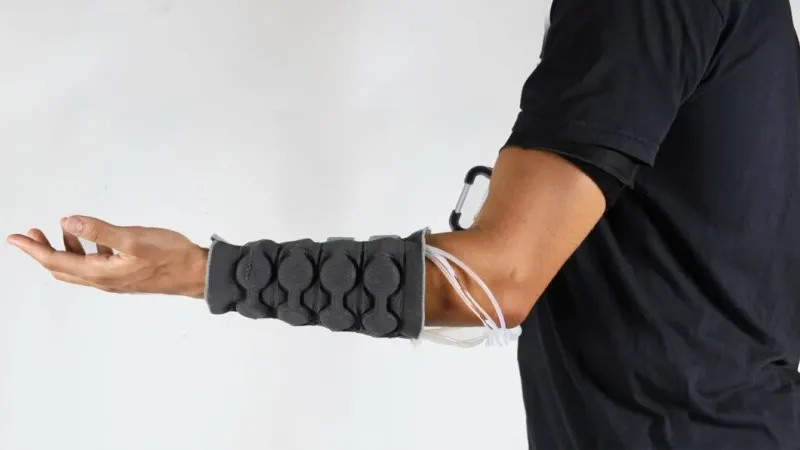New knit haptic sleeve simulates realistic touch
Researchers at Stanford Engineering have developed a lightweight, comfortable knit sleeve that uses pressure-based haptics to simulate touch, opening up new possibilities for wearable devices.

Haptiknit sleeve worn on the arm, including the control system on the upper arm. | Susan Williams, MIT Self-Assembly Lab
This article was first published on
news.itmo.ruWearable haptic devices, which provide touch-based feedback, can provide more realistic experiences in virtual reality, assist with rehabilitation, and create new opportunities for silent communication. Currently, most of these devices rely on vibration, as pressure-based haptics have typically required users to wear stiff exoskeletons or other bulky structures.
Now, researchers at Stanford Engineering have designed a comfortable, flexible knit sleeve, called Haptiknit, that can provide realistic pressure-based haptic feedback. Their design, published Dec. 18 in Science Robotics, shows that pressure may be more effective than vibration for some applications and is the first step toward a new category of haptic devices.
“A device like this opens up a lot of new possibilities for user interfaces – how we experience virtual environments, how we experience remote communication,” said Allison Okamura, the Richard W. Weiland Professor of Engineering at Stanford and senior author on the paper. “It’s much more lightweight, wearable, and comfortable.”
A knit solution
Okamura and her colleagues designed a battery-powered pneumatic system with pressure actuators that were essentially small, inflatable pouches that could be rapidly filled with air. But they needed a way to hold those pouches against the skin without using a clunky exoskeleton.
“If you put air into a balloon next to your skin but don’t anchor it there, it’s going to expand in all directions,” said Cosima du Pasquier, a postdoctoral researcher at Stanford and first author on the paper. “You’re going to waste most of the inflation potential.”
Du Pasquier, who makes clothes as a hobby, realized that knit fabric might hold the answer. The researchers designed a soft textile that would be stiff in some areas – creating an inflexible backing to hold the pressure actuators against the skin – and flexible where needed to allow for movement and comfort.
They worked with a team at MIT’s Self-Assembly Lab to manufacture the Haptiknit sleeve prototype on a knitting machine, with space for eight actuators arranged in two rows. Most of the sleeve was knit from nylon and cotton, but the areas backing each actuator also included a thermoplastic fiber. Once the knitting was done, the researchers used heat to melt the thermoplastic fibers and cause them to harden, stiffening those areas.
Demo video of the “Knit Haptic Pneumatic Sleeve” | Skylar Tibbits, MIT Self-Assembly Lab
“A challenge in the field of soft robotics is how do you stick together something hard and something soft – they tend to delaminate,” Okamura said. “But putting these fibers into knitting makes a totally seamless transition from parts that are hard to parts that are soft, because it’s one continuous fabric.”
The researchers tested the Haptiknit prototype with 32 users. They found that people could more accurately discern the location of individual touches from the pressure actuators than from a similarly arrayed vibrational device. Okamura and her colleagues also tried inflating the actuators consecutively at different speeds to try to create the feeling of a pleasant stroke, as opposed to discrete touches (or the potentially unpleasant feeling of a spider crawling up one’s arm). In general, participants found faster, more overlapping indentation mimicked the feeling of a continuous stroke – the opposite of what the researchers had found for vibration.
The third test was to see if participants could recognize six emotions – attention, gratitude, happiness, calming, love, and sadness – conveyed through the pressure signals. The researchers used touch patterns established in previous research and found that participants generally guessed correctly at a higher-than-chance rate, although the gestures for “calming” and “love” were easily confused.
More comfortable haptics
Overall, participants found the Haptiknit sensations to be equally or more pleasant than those caused by vibrations. They also described the prototype sleeve as comfortable and easy to use, which is promising for more long-term uses.
“What was particularly interesting was that there was a correlation between whether someone had tried a haptic device before and how highly they rated the comfort of our sleeve,” du Pasquier said. “Essentially, if they had tried out other haptic devices, they scored our sleeves much higher.”
With more lightweight, comfortable haptic devices, the researchers are envisioning new opportunities for conveying information through touch. Haptiknit could be used to aid in navigation, military communication, and even dog training, du Pasquier said.
Okamura, du Pasquier, and their colleagues are working on refining and optimizing their knitting patterns, as well as creating larger-scale devices – perhaps even a full suit – for virtual reality interactions. They also hope to incorporate this work into assistive devices that can help people move or aid in rehabilitation.
“We can use this to start testing how people actually interpret and respond to this type of haptic information,” Okamura said. “Whether the purpose is entertainment, communication, training, or physical assistance, this really brings these wearable devices toward things that people might actually want to use in their everyday lives.”
Okamura, a professor of mechanical engineering, is a member of Stanford Bio-X, the Wu Tsai Human Performance Alliance and the Wu Tsai Neurosciences Institute, a faculty affiliate of the Institute for Human-Centered Artificial Intelligence, a science fellow at the Hoover Institution, an executive committee member for the Stanford Robotics Center, and a faculty member of the Center for Design Research.
Additional Stanford co-authors of this research are visiting students Ian Scholl and Liana Tilton.
Other co-authors of this work are from the Massachusetts Institute of Technology and the University of Houston.